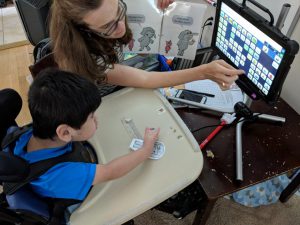 One of our goals for Joey is to speak in multi-word phrases. All children begin with single words, and then over time develop two to three word phrases, before moving on to full sentences. Of course, all children are immersed in examples of how we use multi-word phrases and sentences throughout the day. Although Joey hears oral examples of how to put words together into sentences, it is rare he is able to watch people model using multi-word phrases on a device. Those of us who use the device with him take time to model these phrases, but there is no way to compare our modeling to the total immersion of a typically developing child. [Read more…]
One of our goals for Joey is to speak in multi-word phrases. All children begin with single words, and then over time develop two to three word phrases, before moving on to full sentences. Of course, all children are immersed in examples of how we use multi-word phrases and sentences throughout the day. Although Joey hears oral examples of how to put words together into sentences, it is rare he is able to watch people model using multi-word phrases on a device. Those of us who use the device with him take time to model these phrases, but there is no way to compare our modeling to the total immersion of a typically developing child. [Read more…]
Meet Joey
Most likely, his smile is what you will notice first. Joey has a way … [Read More...]
Accepting Change
I’ve been struggling to write this post for the past month and every time I sit … [Read More...]
BFit power based exercise program
By Janet Sloan
Sponsored by Joey’s Foundation, BFit launched its first full year at MedStar … [Read More...]
Saturday Serenade
By user
Test post for Saturday Serenades https://www.musichealsglennjan.com/saturday-serenades


